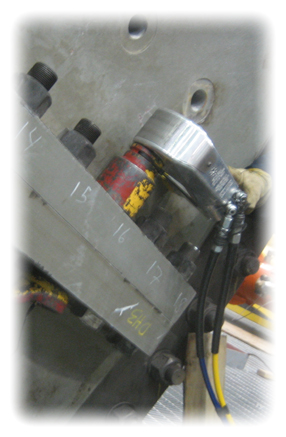the danger of torque.
a misleading and misunderstood bolting process

Nobody disputes that an important condition of bolted joint reliability is that the fasteners must be “tightened accurately”. However, placing the emphasis on applying the “right torque” is completely wrong. Furthermore, so is the almost universally-accepted assumption that as long as calibrated torque tools are used, the desired tightness (or rather, bolt stress) will be achieved. This can't be further from the truth; An applied torque has a dubious and, at best limited, relationship to bolt stress. In fact, a fully torqued bolt could still be completely loose!
It's imperative to understand that "torque" in the common colloquial sense only refers to the applied force rather than the result. This means that when one applies torque, one must faithfully assume (and hope!) that this might result in the necessary bolt tightness.
Consider the following:
As part of the assembly of a new machine, one component was flanged to another with bolts in blind holes. The OEM's installation instructions specified a bolt torque of "x" to be applied by a calibrated torque wrench following a prescribed pattern. During assembly, the mechanics pasted lube to the bolt threads and hand-fitted the fasteners into the holes. A few needed a little extra help because they were slightly tight. Once all of the bolts were in, final tightening was completed with the calibrated torque wrench in a series of repeated passes of increasing levels of torque until a final pass of "x".
A few months later...
Massive machine failure!
A subsequent investigation by the insurance authorities determined that the failure was caused by an unexpected gradual shift of the components during operation. The root cause was attributed to loose bolts leading first, to fatigue failure of some and then, tensile failure of others. After finding that there was no fault with the OEM's design, it was further stated that contrary to the construction report, it was "obvious" that the bolts were not torqued properly. The insurance claim was therefore refused. As to be expected, a litigation battle ensued.
The real root cause...
The two components were assembled with a minor pitch misalignment. This created a slight interference which caused the resistance felt during installation of certain bolts. Unknown to the installation crew, additional tightening force to these bolts caused them to deform in the bores, consequently damaging the threads. In some of the affected holes, the thread damage was so severe that the bolts had become galled. When the torque wrench was inserted onto those bolts, "x" torque was achieved relatively quickly with little arc rotation. On others where the bore interference had been less, the wrench stayed on much longer and moved the bolt heads through a greater rotation before "x" was indicated.
Remembering that torque is only an indication of the resistance felt to the rotational moment, it should now be clear that the application of the tightening force was incorrectly stopped before the bolts were fully tightened - even though the proper torque was applied!
Since they followed the OEMs instruction and adhered to the torque specifications, the Owner and the mechanical installation contractor were exonerated; the insurance claim was paid out.
The above failure was caused by improper geometry leading to excessive frictional resistance. If the designing engineer had been lucky and and somehow predicted this additional friction, a higher torque spec would have been calculated. However, all of the other bolts would have been over-tightened!
It's not only misalignment which can create unexpected friction; there are myriad other uncontrollable factors including:
- thread condition
- tolerance imbalance
- insufficient lubrication
- excessive lubrication
- contaminated lubrication
- faying surface condition
- flange rotation
- washer condition
- tool condition
- and on, and on, and on...
One can clearly see the designer's dilemma: Which Friction Coefficient must be used when calculating torque? Alas, unless we live in a world where we're all competent fortune-tellers, it's impossible to predict how much friction might be encountered whenever a fastener is tightened. As a result, if the same torque is applied to each bolt within a common flange, the actual "tightness" of each fastener may vary considerably; some may be too tight, some may be too loose, some may be just right. The saving grace is that in most flanges, a wide variation in actual-to-necessary bolt stress values can usually be tolerated for two reasons:
- the joint is over-designed
- the cost of joint failure is minimal
On the other hand, there are many applications where the reliability and safety of the equipment or structure cannot be compromised. In those cases, the integrity of the bolted joints should never be based on assumptions and hopes.
Summary
The torquing procedure as accepted by the vast majority of individuals, manufacturers, societies, associations and authorities is backwards. Or, rather, it's incomplete. To avoid risks by having to guess that a flange has been tightened adequately, the tightening procedure on critical applications must be supplemented by a verification step, either during assembly or afterwards. For the most part, this means that the actual torque value is of no significance since it will often vary in order to develop consistent bolt clamp load.
On-site Verification. Our speciality.

